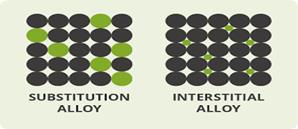
Concept explainers
Interpretation:
The two types of metal alloys needs to be compared.
Concept introduction:
When there is combination of metals or metals that are combined with one or more elements then we get alloy. The elements like gold, silver, iron, non metallic carbon, combined with other elements to give alloys. Alloys have properties which have increased strength and hardness, corrosion resistance, and has good mechanical strength. It is used in buildings, tools, automobiles, etc.
Answer to Problem 90A
Interstitial alloys gets into the spaces between the lattice points while substitutional alloys have their atoms occupy the space of the lattice points.
Explanation of Solution
The two types of alloys are interstitial alloys and substitutional alloys. In interstitial alloys, small diameter atoms like hydrogen, carbon, nitrogen, carbon gets into the spaces between the lattice points. In substitutional alloys, the atoms of new element occupies the space of the lattice points.

| Interstitial alloys | Constitutional alloys |
| The atoms occupying the space between the lattice atoms are not same size | The atoms occupying the lattice space are of the same size. |
| There is no substitution of the atom | There is substitution of atom |
| Example is steel | Examples are Bronze, Brass |
Interstitial alloys gets into the spaces between the lattice points while substitutional alloys have their atoms occupy the space of the lattice points.
Chapter 7 Solutions
Chemistry: Matter and Change
Additional Science Textbook Solutions
Chemistry: The Central Science (13th Edition)
Chemistry: A Molecular Approach
Organic Chemistry (8th Edition)
Introductory Chemistry (6th Edition)
Chemistry: Structure and Properties
Chemistry: Structure and Properties (2nd Edition)
 ChemistryChemistryISBN:9781305957404Author:Steven S. Zumdahl, Susan A. Zumdahl, Donald J. DeCostePublisher:Cengage Learning
ChemistryChemistryISBN:9781305957404Author:Steven S. Zumdahl, Susan A. Zumdahl, Donald J. DeCostePublisher:Cengage Learning ChemistryChemistryISBN:9781259911156Author:Raymond Chang Dr., Jason Overby ProfessorPublisher:McGraw-Hill Education
ChemistryChemistryISBN:9781259911156Author:Raymond Chang Dr., Jason Overby ProfessorPublisher:McGraw-Hill Education Principles of Instrumental AnalysisChemistryISBN:9781305577213Author:Douglas A. Skoog, F. James Holler, Stanley R. CrouchPublisher:Cengage Learning
Principles of Instrumental AnalysisChemistryISBN:9781305577213Author:Douglas A. Skoog, F. James Holler, Stanley R. CrouchPublisher:Cengage Learning Organic ChemistryChemistryISBN:9780078021558Author:Janice Gorzynski Smith Dr.Publisher:McGraw-Hill Education
Organic ChemistryChemistryISBN:9780078021558Author:Janice Gorzynski Smith Dr.Publisher:McGraw-Hill Education Chemistry: Principles and ReactionsChemistryISBN:9781305079373Author:William L. Masterton, Cecile N. HurleyPublisher:Cengage Learning
Chemistry: Principles and ReactionsChemistryISBN:9781305079373Author:William L. Masterton, Cecile N. HurleyPublisher:Cengage Learning Elementary Principles of Chemical Processes, Bind...ChemistryISBN:9781118431221Author:Richard M. Felder, Ronald W. Rousseau, Lisa G. BullardPublisher:WILEY
Elementary Principles of Chemical Processes, Bind...ChemistryISBN:9781118431221Author:Richard M. Felder, Ronald W. Rousseau, Lisa G. BullardPublisher:WILEY





